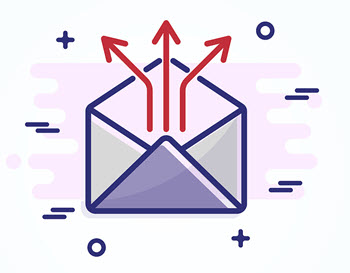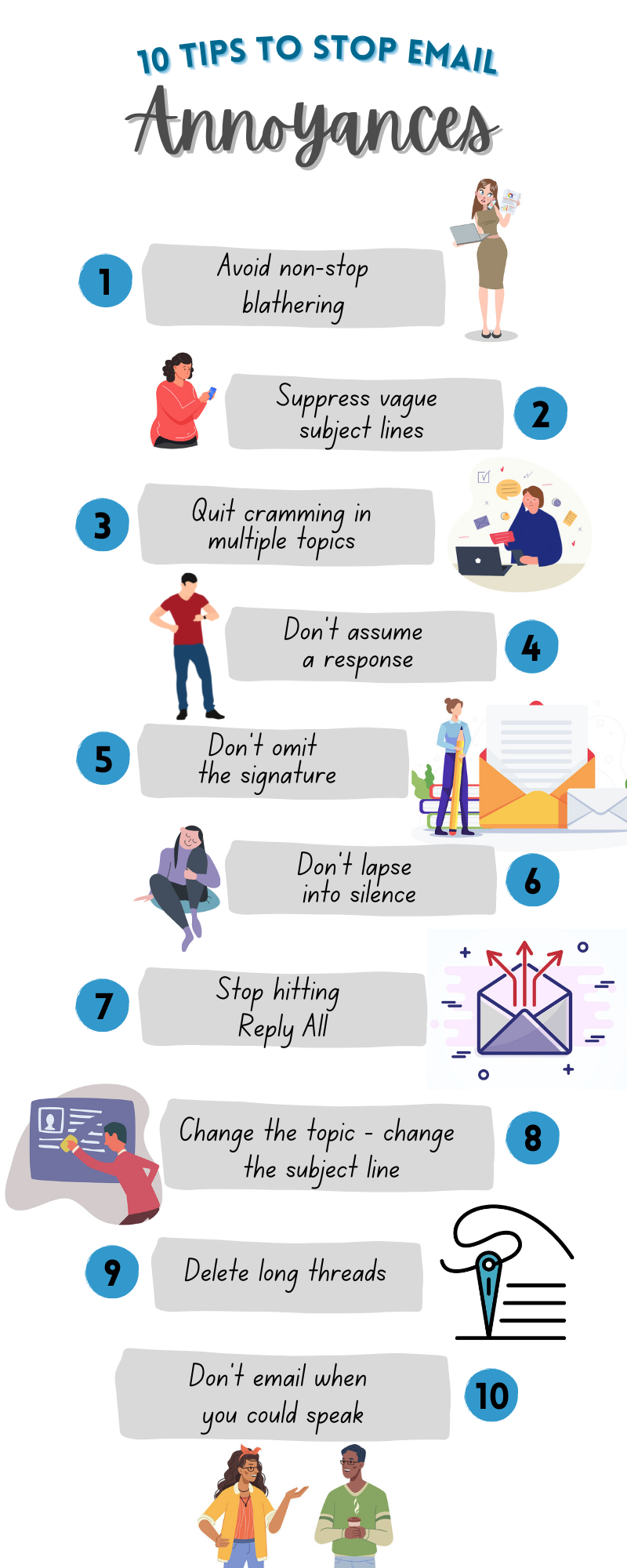 Email is often abused, attacked, and declared dead. Despite the bombardment, email endures.
Email is often abused, attacked, and declared dead. Despite the bombardment, email endures.
That does not mean this form of communication cannot be annoying. Oh, let me count the ways. So, what can you do to reach the full value of email without annoying your targeted audience?
The following are 10 tips for erasing the annoying for better business communication.
Email Annoyances
Like any breakdown in communication, more than one party can contribute to the problem. Both the sender and the recipient generate email annoyances. So, the following reviews tips for each party.
Note: For purposes of this post, the focus is on non-marketing emails. Annoying marketing emails are a post for another day.
Sender-Generated Annoyances
A reported 4.03 billion people worldwide use email. And they’re busy sending or receiving more than 319 billion emails per day. Doesn’t sound very dead, does it?
The first five tips to annihilate annoyances focus on the individual sending the email.
 Tip #1 – Avoid non-stop blathering
Tip #1 – Avoid non-stop blathering
Even the perpetrators of wordy, boring emails hate being on the receiving end. (We never think that applies to our emails, right?)
Any business communication should focus on the audience. So to stop blathering, imagine you are standing before your company’s (or client’s) busy executive. The one who hates to waste time.
- Get to the point quickly
- Add relevant information.
- Then stop talking.
But how much information is too much?
One person’s relevance is another person’s annoyance.
- Learn what the recipient prefers.
- Do they delight in data? Abhor attachments? Wince at wordiness?
- When in doubt – less is more.
That last point is especially true for group emails. No matter how well you know the group you are emailing, you are going to have a mixed bag of preferences. So, keep emails short and sweet.
Get to the point of your email in the first few lines. Share on XTip #2 – Suppress vague subject lines
Where is the first place you look when accessing your email? I bet you answered the subject line. Okay, some of us check out the sender first. Assuming the sender passes that test, the next stop is the subject line.
- Think of your email as a marketing opportunity.
- Would you send a vague, boring subject line?
I know, I know. I said this was not about email marketing. But even internal emails benefit from a marketing perspective. Typically, you hope to inform, educate, or persuade.
Specific subject lines deliver a clear purpose.
- Vague Subject Line – Meeting Scheduled– If you are like most business professionals, you have plenty of meetings. So which meeting is this one?
- Better Subject Line – XYZ Client Meeting Scheduled – Your Attendance Required – You know which meeting and that you are expected to attend.
A good business email subject line is simple and specific.
Tip #3 – Quit cramming in multiple topics
You know how movies list the credits at the end? How many of you read them? Maybe you do if you are one of those names on the rapidly scrolling list. Otherwise, you probably do not bother.
- Too many names
- With little or no relevance
- And scrolling way to fast to read
If we cannot grab the significance to us in the first few seconds, we move on. Consequently, emails with too much ‘stuff’ increase the likelihood readers will miss important details.
Send one topic per email.
I found this out the hard way. Occasionally, I added requests to an email that had my billing invoice attached. Guess what got overlooked? More than once.
Yep, the invoice. The recipient would answer my other question and forget about processing my bill.
- Lesson learned
- My invoice stands alone
One topic per email keeps readers focused on your message.
Tip #4 – Don’t assume a response
How many times has this happened to you?
- An email is sent to a group of people.
- You need a response by a certain date.
- As the date approaches, few have responded.
Before you assume the problem is with the other party, review your email.
- Did you tell them a response was required?
- Was a due date for response provided in the email?
- Were the requirements clear or did you bury them in details?
You have multiple options to fix this problem.
- List requirements in the beginning of your message.
- Use bullet points or bold to emphasize critical information.
- Keep messages scannable and brief.
If you want a response to an email, tell recipients what you expect.
Tip #5 – Don’t omit the signature
Technology simplified connection – except when we do not use it.
Email allows a signature with your name and contact information. In my corporate days, it was a major pet peeve of mine to receive an email with no signature.
If I wanted to call, I had to stop to find the number in my rolodex (in the really old days) or in my address book.
- A signature eliminates searching for a call-back number.
- Today, a simple click on the number from your smartphone connects you.
Most smartphones allow you to change your signature from the Sent from [device name] default.
Make connection simple. Use email signatures with contact information on all your devices.
Recipient-caused Annoyances
People sending emails are not the only individuals playing the annoying email game. The people receiving emails are an equal opportunity annoyer.
The last five tips are suggestions for email recipients.
Tip # 6- Don’t lapse into silence
We are all buried in too much email. However, there comes a point when silence lingers too long.
- Was there a technology glitch?
- Did the email get caught in the spam filter?
- Or is the recipient disorganized?
The sender may think any of those or worse. There is a simple solution.
I’ve recommended this before. A simple, I received your email and will get back to you tomorrow works wonders. Assuming you get back to them tomorrow.
Simple acknowledgment has multiple benefits.
- The sender knows you received the email.
- You’re saved from the bombardment of follow-up emails.
- It buys you more time to respond – if you need it
However, the greatest benefit of acknowledgment is it shows how responsive you are. Customers love it.
Break your silence. Acknowledge business emails promptly. Share on X Tip #7 – Stop hitting Reply All
Tip #7 – Stop hitting Reply All
Is there anything more aggravating than being copied on tons of responses you do not need?
For example, a coworker is organizing an event.
- He sends an email to you and 10 other colleagues.
- It includes a lunch menu for the meeting and asks for your selection.
- You (and the 10 other colleagues) hit Reply All.
Seriously? Do I need to know you want your dressing on the side?
Banish ‘Reply All’ from email responses colleagues do not need.
Tip #8 – Change the topic – Change the subject line
Do you receive emails with a long string of replies? One where the latest reply has nothing to do with the original topic? Me, too.
Because the subject line is one of the first places you look, you may dismiss the email as one you responded to. Especially since everyone loves to hit Reply All.
I know. It’s easier to hit Reply All so you do not have to re-enter the email addresses. Fine. Simply update the subject line so we know there is a new topic.
Changing a business email topic? Please update the subject line. Share on X Tip # 9 – Delete long threads
Tip # 9 – Delete long threads
The above tip leads nicely into this next tip.
Stop trying to go for a Guinness World Record for the longest email thread.
Yes, some email services include “clean-up” options. But isn’t it nice when we all work together to stamp out excess?
Delete the long tail of business email redundancy.
Tip #10 – Don’t email when you could speak
 This last tip applies to senders AND recipients.
This last tip applies to senders AND recipients.
- Do you really need to send an email?
- Will a call get you what you need?
- Would a walk down the hall?
In my corporate cubicle days, I never understood why someone sitting on the other side of that wall felt the need to email me.
I often replied (by voice), Hello. I’m sitting right here. Ask me.
I agree there are situations when written documentation is both appropriate and smart. A response to the question, Do you want me to pick you up a Starbucks? is probably not one of those times.
Face-to-face conversations trump email. Talk to me.
How Annoyed Are You?
Do you sense I could go on and on? How annoying is that?
Share your email annoyances in Comments. If nothing else, you’ll feel better.
==================================
Note: In 2015, SSB took a year-long alphabetic journey for better business communication. Each post contained an A-to-Z topic for creating better business communication. This ‘E’ post originally published on March 16, 2015, and this March 30, 2022 version updates it. The plan is to update each alphabetic post. Hopefully, it will not take a year to complete. 😊
===================================


Vague subject lines make me crazy! When the topic changes I do this in the subject line:
old topic / new topic – seems to help with the continuity.
And you left out my favorites – delete and un-subscribe! 😉
Good suggestion, Anne. I ♥ delete/unsubscribe, too. 😉
Cathy,
You hit my number one annoyance, neglecting to include a signature. It’s so easy to automate, and so many refuse to do it. Grrrrr.
Thank you, Bob! I thought I was the only one. 😉 I’ve never heard anyone else complain about it. As I said, it drove me nuts in my corporate days.
Thanks for sharing our mutual frustration, Bob. 🙂
Cathy, I’m with you on the emails with cramming several subjects into one message. And “reply all” drives me crazy, especially when people respond days later! Aarrgh!!
I think some believe multiple topics in one email cuts down on the number of emails. But usually the opposite happens because you have to send more for all the times people miss that part of the message.
And I feel your pain with the Reply All. Don’t miss those from my corporate days. Thanks for sharing your insight, Marcie. 🙂
Great list, Cathy. Great reminder to “do unto others….” If such practices annoy us, good chance they annoy others, too. Re: the quick acknowledgement. Isn’t it refreshing when people respond right away? Quick responses make me feel like the recipient cares, and my estimate of her as a professional goes up a notch. Which reminds me — I have a few to respond to.
Thanks, Cheryl. Acknowledgement is so important. We all want to feel validated and like you said, it makes the person responding look good as well. So simple, yet so often neglected.
Thanks for stopping by, Cheryl, and sharing your thoughts.